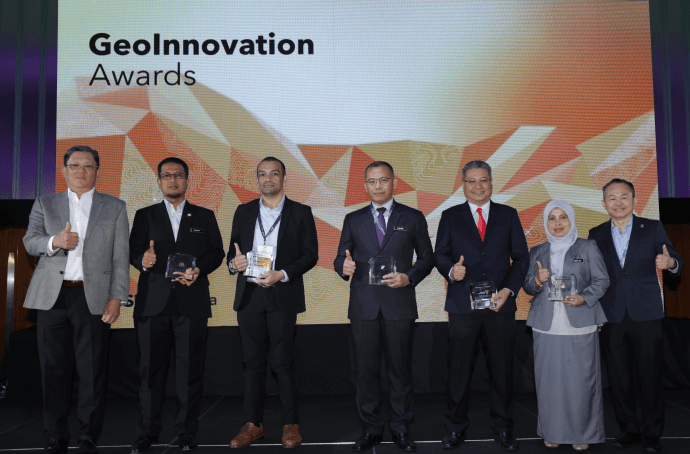Cutting edge GIS technology applications were presented at the 2024 Esri Malaysia GeoInnovation Awards, demonstrating how the visualisation of data amplifies business impact, synchronises workflows across verticals and supports community service.
Some of Malaysia’s most progressive organisations recently met to discuss how location analytics is spearheading digitisation and five were recognised with prestigious GeoInnovation Award.

Bahagian Geospatial Pertahanan (BGSP)
The defence geospatial organisation plays a critical component in the training of GIS technology and advisory services for the Malaysian Armed Forces (MAF). BGSP also supports MAF’s programs in response to humanitarian, natural disaster and defence and security needs. GIS technology plays a critical role in enhancing the organisation’s ability to forecast and protect citizens during times of emergency.
One example - during the pandemic BGSP developed a joint common operating picture to visualise on-the-ground situations in near real-time, informing decision makers to execute at a tactical level to manage outbreaks. BGSP is also playing a critical role to integrate data across other agencies.
Alam Flora
A leading environmental management company in Malaysia, Alam Flora, collects more than 4000 tonnes of waste per day, with the bulk of the work carried out by 1000 specialist trucks. These waste disposal units provide service to residents across a vast 36,424 square kilometre area, underpinned with real-time, location analytics. Alam Flora continues to streamline workflows with the support of geospatial technology.
The largest concession holder of Malaysia’s national solid waste management and public cleansing project has digitised its reporting methods, interpreting data from a comprehensive 360-degree view of works undertaken and completed, including fleet tracking. This has greatly reduced the need for staff to visit sites and manually report, providing a more efficient overview of activities.
Dewan Bandaraya Kuala Lumpur (DBKL)
Tasked with keeping a bustling city of more than 8.8 million people moving, DBKL scaled existing capabilities to address common operational challenges with innovative thinking. Before undergoing any maintenance works or planning, DBKL was required to consult with each of the city’s utility agencies to gain access to location analytics of pipelines or underground energy grids. Streamlining access to the data gives DBKL a fuller picture of operations, used to support installation of new cables, or respond to natural disasters.
Tenaga Nasional Berhad (TNB)
The green energy transition requires upgrades to the nation’s power grid. To meet energy demand and manage land asset valuations, TNB - responsible for generating, transmitting and distributing electricity to homes and businesses – has developed a land resumption system, to support the infrastructure projects to build future powerlines.
Previously, land value data was manually processed, resulting in opportunity for error, which led to a disparity in costing estimates in budgets and land acquisition.
The opportunity for error is now greatly diminished with the development of a centralised data hub. Now, staff have the capability to map and analyse land value information regarding grid infrastructure siting proposals within the Grid Land Planning system, providing business units with the flexibility to optimise their investments, most notably those involved in transmission line route and substation site selection and land acquisition.
Majlis Perbandaran Batu Pahat (MBPB)
To consult with community on planning and development activities as part of its smart and low carbon city initiative, the council built the MBPB Smart GIS portal. Feedback from the community is allocated to a department for response, with the aim of improving resident’s quality of life. The council’s geospatial database platform, SmartGIS MPBP, functions as a reference centre for all information related to planning and development, as part of a five-year transformation program through to 2025.
The digitisation process translates to a streamlined, accurate and reliable system. MPBP’s role is to ensure that all development planning is implemented successfully and to publicise its land use plans, zones and development to the community. The single point of truth is accessed by 50 users in the council and data is updated in near real-time – a radical improvement to the former manual system.
If you would like more details or have any questions, please contact the media team.
